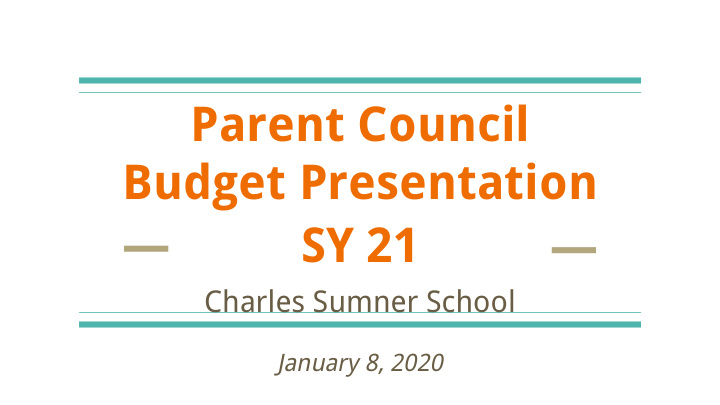



Parent Council Budget Presentation SY 21 Charles Sumner School January 8, 2020
What is Weighted Student Funding? Weighted Student Funding (WSF) is BPS’s current way to distribute resources to schools based on a per pupil allocation with the dollars following students, instead of a program, school, or building. “Weighted student funding is more equitable, transparent and predictable.” per BPS
Projected Numbers Determine Enrollment → Enrollment Drives Budget → Budget Drives Staffing →
Budget given to principals 12/12/19. A balanced budget must be finalized by January 13, 2020 Budget Lines Fund 200: Specific Population Fund 100: General Fund needs/Grants ● Money from Weighted ● Supplies ($55-$65/student) Student Funding Substitutes ($168 * 9 days per ● FTE teacher) ● English as a Second Language ● Used Primarily for Staffing needs Stipends, if possible ●
Projections (calculated across 5 years … .) 1. Maintain current 30 classrooms & strands 2. Overall projected to be 524 students in Fall 2020 a. (as of Jan 2020, we are 529 students) 3. 86% filled….. We are not fully funding every classroom because each student = $$ Example: Kindergarten class has 18 students when 22 seats available = short $34,816 for 4 unfilled seats (each K student = $8,704)
Projections (calculated across 5 years … .) Drop in enrollment: K2 - Grade 2 General Education = loss of 10 students versus 25 projected last year Grades 3 - 5 General Education = loss of 16 versus 6 projected last year K2 and Grade 1 SEI-Spanish: smaller cohorts, current K2 SEI started at only 8 students!
Projections (calculated across 5 years … .) Middle of the road enrollment….. Inclusion = 29 of 35 seats expected to be full versus 31/41 seats filled last year Strong enrollment….. Specialized programs = Learning Disabled projected to be almost full
District investments and cost associated 1. All Kindergarten classrooms must have full time classroom paraprofessionals = $40K each 2. All schools must have full time nurses = we already have this 3. All teacher and paraprofessional salaries have increased by 7-12%: school pays for it
Compliance requirements & cost associated 1. Supplies = $29K 2. Substitutes = $59K 3. 2 ESL teachers = $202K 4. 1.5 Resource Room teachers = $151K 5. Special Education Coordinator 6. Secretary 7. Physical Education for every student
Bottom Line Although our overall allocation is $5.1 million, that doesn’t cover the salary increases & loss of 26 students….. = deficit of $161,000
School Site Council’s Role The SSC reviews, comments, and signs off on the budget to ensure it is balanced and aligned to the Quality School Plan (QSP).
So what will we be able to fund next year? ● Current 30 classroom configuration of 3 - 5 homeroom teachers per grade level ■ Some smaller classroom sizes like this year ● Specialists for students but not extra blocks like now ○ Required to have 6.6 specialists not the 8.2 we have now
What might we not be able to fund next year? ● 1.0 Specialist ● Assistant Principal ● Compliance paraprofessionals but not extras ● Community Field Coordinator
What are the next steps? ● See what we can advocate for this winter/spring ● “Development” arm to write grants ● Public relations to increase our enrollment ● Communication with departing families so we can enroll another student before the District does Oct 1 student “count” for next year’s $$$
Budget Collaborative - January 2019 Principal meets with central office departments to ensure that the budget meets the needs of all students. Probable Org - February 2019 Principal meets with Office of Human Capital (OHC) and other central office departments to review staffing template.
Recommend
More recommend